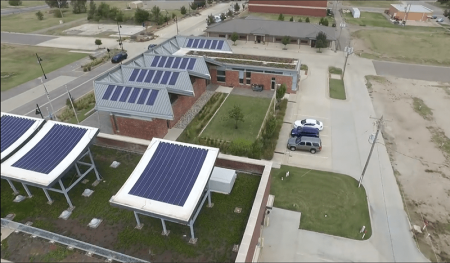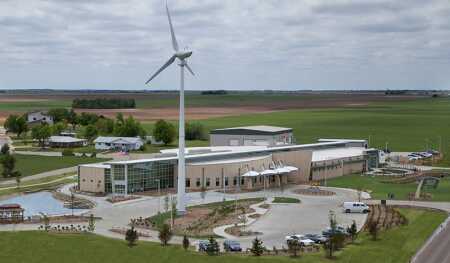Cities and towns around the world are committing to increased use of solar, wind, geothermal, biomass, and hydro energy, and many have achieved some level of success. But only a handful can claim they are 100 percent powered by renewable energy.
Building, and then maintaining, a green-power portfolio requires more than cutting off energy from the local fossil fuel–burning plant and plugging into the wind or solar farm. For a municipality to obtain its energy from renewable resources, “it has to be cost-effective, it has to fit into a current system and infrastructure that’s largely geared toward unrenewable energy, and a transition has to take place,” says David Richardson, executive director of Impax Asset Management, which invests in global sustainability initiatives.
The Cost-and-Infrastructure Conundrum
When Georgetown, Texas, issued bids for companies to serve its power needs, “the absolute lowest-cost bids were from wind farms,” said Chris Foster, manager of resource planning and integration for Georgetown Utility Systems. The transmission grid links Georgetown, an Austin suburb, to a Texas Panhandle wind farm hundreds of miles away. When Georgetown needed to fill a remaining gap in its power portfolio, the cheapest power sources for that additional energy were solar and natural gas, he says. Though their prices were similar, “solar providers could give us a long-term contract, for a good price,” Foster notes.
Officials in Burlington, Vermont, and Greensburg, Kansas, also cited lower cost per kilowatt-hour as a powerful incentive to switch to renewable energy. longer contracts, which guaranteed price stabilization.
However, while the power is less expensive, the economics might not work for every community. One reason it works for Burlington, the first U.S. city to be powered exclusively by renewables, is that the city itself owns the biomass McNeil Generating Station. It also owns Winooski One, a hydropower plant on the Winooski River, just north of town. The city also manages solar panels at Burlington International Airport, which contributes to the renewable mix, says Darren Springer, chief operating officer with Burlington Electric Department (BED), the city-owned utility.
The economics also work for Greensburg because the ten-turbine, 12.5-megawatt Greensburg Wind Farm provides all the town’s energy.
Municipalities that succeed with renewables “tend to be small cities that are located near good sources of renewable energy,” says Dan Chorost, a partner with the New York City environmental law firm of Sive, Paget & Riesel. Georgetown, unlike Greensburg, is not near its wind farm, but Texas invested in the necessary infrastructure to bring renewable power to the people, Chorost says. “Other cities don’t have that luxury and would need a patchwork of energy sources that feed into the grid,” he adds.
That patchwork would involve switching from the current model of one power plant and many transmission lines, to micro-utilities, which would require a different way of thinking than most Americans are accustomed to, Richardson says. In Europe, few people mind having windmills or wind turbines dotting the landscape. “If you travel to Germany, you see solar panels and wind turbines everywhere,” he says. “That might not be quite as acceptable in the United States.”
It also can also be difficult to feed renewable energy into current power distribution networks. An EF-5 tornado leveled about 95 percent of Greensburg in 2007. When it came to getting the power back on, “we weren’t dealing with existing infrastructure. That had been wiped off the map,” explains Greensburg Mayor Bob Dixson. “That made our situation a little more unique than an existing city that might be trying to accomplish these goals.”
Utility ownership is also important. Burlington, Georgetown, and Greensburg operate their own utilities. Other cities and towns have utilities owned by outside shareholders who might not have renewable energy as a priority. Ken Nolan, general manager of the Vermont Public Power Supply Authority and former chief operating officer of BED, says that though working through shareholder-owned utilities does not make it impossible to move toward a renewable mind-set, “the city might not have a direct line to the controlling utility.”
Another important part of the equation in becoming a 100 percent renewable-energy city can be reducing demand through energy efficiency. “Investing in energy efficiency is cheaper than generating more fossil fuel or renewable energy,” says Billy Grayson, executive director of the Center for Sustainability and Economic Performance at the Urban Land Institute. Studies show that it costs about 2.8 cents per kilowatt to reduce energy consumption—far less than it costs to generate that much electricity using coal, natural gas, or wind or solar power. By reducing demand, cities can spend less on energy and even use savings from energy efficiency programs to pursue renewable energy investments with a longer payback and lower return on investment.
Keeping the Lights On
A major concern regarding renewable energy is that service can be intermittent. “Most municipalities need power 24 hours a day,” says Edward Zaelke, head of the global projects and finance practice at Akin, Gump, Strauss Hauer & Feld LLP. To achieve 100 percent renewability, a town or city has to buy the power it needs when it is available—and trade power when it is not.
One approach is to have a broad portfolio of renewables. The best renewable portfolio is a multifaceted one. “Wind and solar can be produced at high levels, at different times of the day, and can be buttressed with biomass or geothermal,” says John Marciano, a partner with the global projects and finance practice at Akin, Gump, Strauss Hauer & Feld. “I’ve seen military bases do this, and data centers.”
Another approach is to have the ability to store power for use when the sun does not shine or the wind does not blow. However, there is currently a lack of storage capacity, and the small amount storage available is expensive, undermining cost-effectiveness. “As battery technology becomes better developed, we’ll likely see municipalities go to a 100 percent renewable situation,” Zaelke says.
Storage costs are starting to decline. Richardson says Impax is keeping an eye on batteries. “Over the next five to ten years, things could get interesting,” he says.
No Silver Bullets
Though the experts have different thoughts regarding renewable use, all agreed there is no one-size-fits-all solution. The best way to start down the green path is to examine the resources available, understand the utility that provides the power, and ensure buy-in from the community.
As long as a city’s leadership supports developing a renewable energy portfolio and provides a clear direction on how to achieve it, such a portfolio can become a reality, Nolan says. However, achieving 100 percent reliance on renewable energy resources requires a great deal of dedication, including time and effort, he says.
“Burlington took the first step in 1984 when it turned on the biomass plant,” he says. “In 2014, they made it to 100 percent. The ten to 12 years before that were a concerted effort to get there.”







